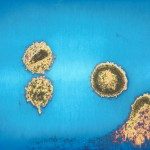Link to Pubmed [PMID] – 11152522
J. Virol. 2001 Feb;75(3):1507-15
Live attenuated simian immunodeficiency virus (SIV) is the most efficient vaccine yet developed in monkey models of human immunodeficiency virus infection. In all successful vaccine trials, attenuation was achieved by inactivating at least the nef gene. We investigated some virological and immunological characteristics of five rhesus macaques immunized with a nef-inactivated SIVmac251 molecular clone (SIVmac251Deltanef) and challenged 15 months later with the pathogenic SIVmac251 isolate. Three animals were killed 2 weeks postchallenge (p.c.) to search for the challenge virus and to assess immunological changes in various organs. The other two animals have been monitored up for 7 years p.c., with clinical and nef gene changes being noted. The animals killed showed no increase in viral load and no sign of a secondary immune response, although the challenged virus was occasionally detected by PCR. In one of the monkeys being monitored, the vaccine virus persisted and an additional deletion occurred in nef. In the other monkey that was monitored, the challenge and the vaccine (Deltanef) viruses were both detected by PCR until a virus with a hybrid nef allele was isolated 48 months p.c. This nef hybrid encodes a 245-amino-acid protein. Thus, our results show (i) that monkeys were not totally protected against homologous virus challenge but controlled the challenge very efficiently in the absence of a secondary immune response, and (ii) that the challenge and vaccine viruses may persist in a replication-competent form for long periods after the challenge, possibly resulting in recombination between the two viruses.

